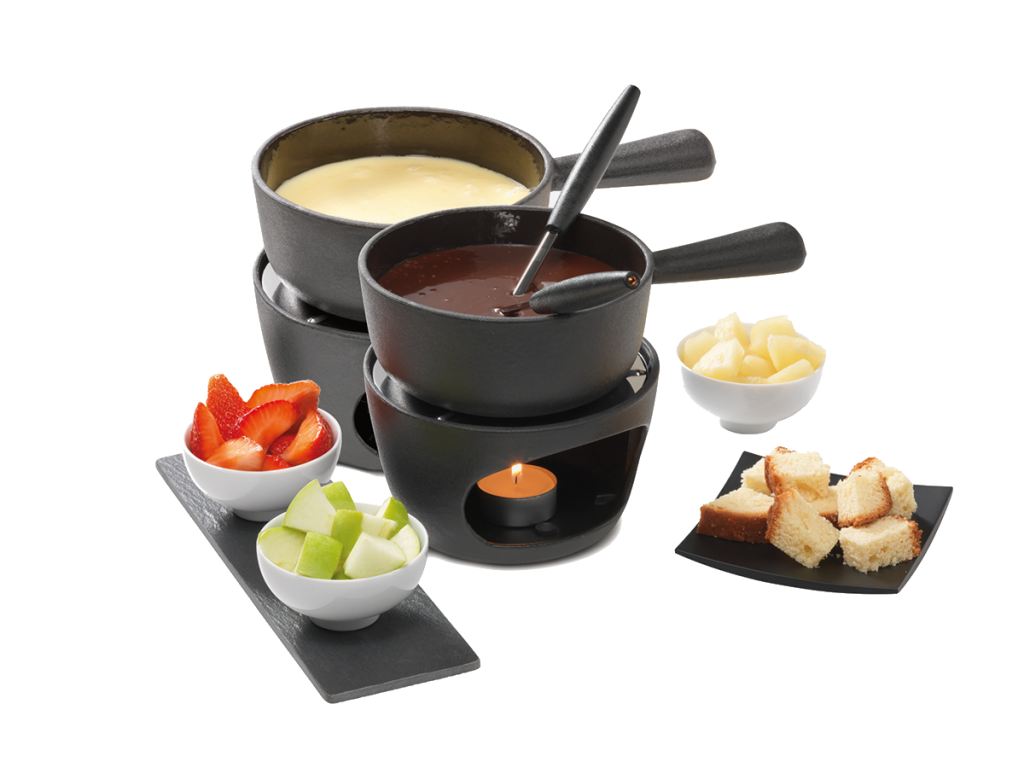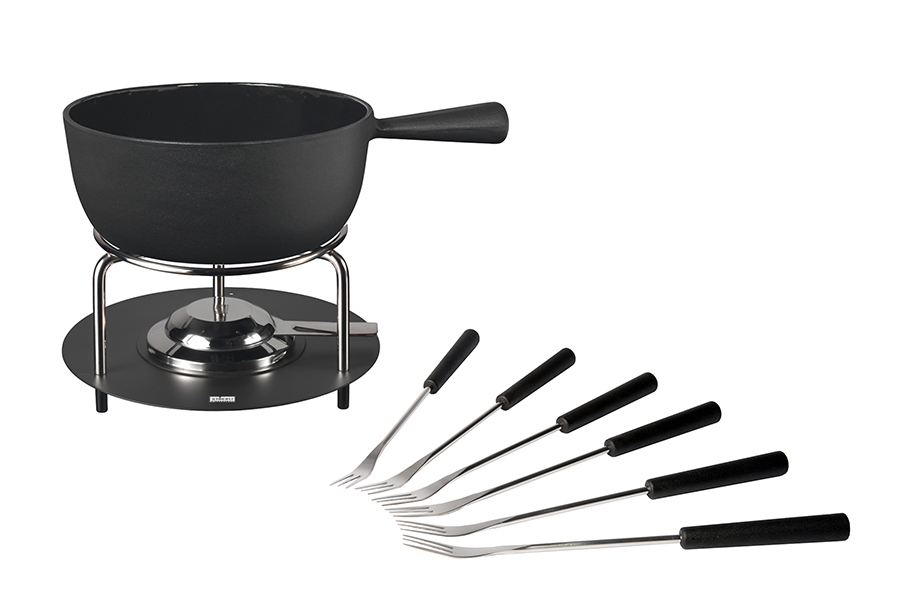Enjoy a fondue at a beautifully laid table. Here you will find fondue sets for cheese, fondue chinoise or beef bourguignonne fondues. Furthermore, the set comes in different sizes and materials, as well as caquelons that can be used on induction cookers. Experience the pure joy of fine dining and a lust for life through appropriate place settings, plates, forks and other chic accessories. In short, try it yourself!
Have fun with fondue
Stöckli and fondue have a long history together. Either traditionally with cheese, or as fondue chinoise or beef bourguignonne, the choice is yours when it comes to fondue. For example our Titlis fondue set. The light wooden handle forms a nice contrast to the induction-capable, robust, black cast iron pot with splash guard, and can be stored in a space-saving manner. The cast iron rechaud has a wooden base and is provided with a paste safety burner. The set includes six meat fondue forks with wooden handles.
For young and old
Whether for a date with your sweetie, with friends or with the whole family, fondue is always a joy! Cheese, fondue chinoise or beef bourguignonne fondue has become a tradition in every gourmet household. Moreover, the easy preparation ensures an evening that won’t be forgotten in a hurry.
Have fun with fondue
Stöckli and fondue have a long history together. Either traditionally with cheese, or as fondue chinoise or beef bourguignonne, the choice is yours when it comes to fondue. Caquelons made of ceramic, cast iron, steel-enamel or stainless steel – it is a matter of personal taste. Your fondue will be unforgettable no matter which set you choose.

The original
Celebrate the nostalgic cheese fondue with the Classic Rechaud of Stöckli: the classic rechaud with methylated spirits provides an adjustable wick burner and a large tank.
Thanks to the wind shield, you can also enjoy your fondue outdoors. Available separately.
Did you know what a “Lädeli zur Schererei” (paper cutting boutique) offers? What is a Schererei? We will solve the riddle for you. There are some people who love cutting paper silhouettes. Jolanda Brändle from Mosnang is one of them, having dedicated herself to this art with all her “heart and soul”. Stöckli asked her to design an Ascent to the mountain motif to decorate our fondue caquelon, as well as six decorative themes for the plates. Jolanda Brändle conjures up filigree silhouettes by hand, genuine works of art that tell their own stories. It’s a very special art and represents craftsmanship at its best!
Elegant electric rechaud
The fondue chinoise is a traditional Christmas dish in Switzerland, forming an integral part of Christmas for many families and couples.
What more could you want for Christmas than to spend time together at home, particularly when the world outside is covered in snow or obscured by thick clouds of fog?
This delicious fondue is easy to prepare for any amount of hunger.
China is on the way to becoming the world leader in distribution. And this thanks to the e-commerce giant Alibaba, which is increasingly imposing its “New Retail” model.
The history of e-commerce in China is very different from that of the United States or Europe. Its real kick-off was given by the company Alibaba, which began by connecting buyers and sellers with a very BtoB logic. Today, Alibaba is the largest online retailer in the world: in 2017, it had an annual business volume (transactions that take place on its platform) of $547 million.
During “Singles’ day” – the day of Chinese singles, on November 11, during which brands compete with promotions – sales exceed those of “Black Friday” and “Cyber Monday” in the United States combined. In 2018, Alibaba smashed records by achieving more than 30 billion euros in turnover in 24 hours.
Jack Ma’s company never ceases to want to modernize trade in China (see also the column: “Alibaba: the first real challenge to Amazon’s economic model”). And this notably involves five practices that we could soon see being adopted in France.
1. “Smart pop-up stores”
“Smart pop-up stores” are ephemeral stores whose ambition is to combine online sales and physical sales, while personalizing the customer experience. In this type of store, only a representative sample of products is stored. To have access to more sizes or colours, customers can approach an item fitted with an RFID chip to the “cloud shelves” (interactive screens giving access to the online sales platform). They can then scan the QR code of a product, so as to buy it via their mobile phone and continue their shopping without being encumbered by their purchases.
2. The digitization of convenience stores
Alibaba has launched the “Ling Shou Tong” (or “Integrated retail”) initiative aimed at helping local businesses, convenience stores and other small family-run shops that abound in China, to also take the digital shift, by providing them with assistance in terms of stock management and logistics. For example, the smallest physical store can now, thanks to the help of Alibaba and its wealth of available data, know the socio-demographic profiles and purchasing behavior of shoppers in its area to adapt its assortment.
Weijun Grocery, a grocery store located next to Zhejiang University in Hangzhou, joined the program, before being chosen to test the Alibaba franchise system (Tmall Corner Store). The store owner said his revenue increased by 45% in the last quarter of 2018, compared to the previous year, and his store traffic increased by 26%.
3. Retail as entertainment
Shopping is increasingly becoming a hobby in China. For example, while having lunch, Chinese consumers can scan QR codes affixed to the restaurant table with their smartphone. This then gives them the right to promotions, for example on clothes sold in the shops of the shopping mall where they are eating. The clothes have been specifically chosen for them based on their previous shopping behavior, the videos they have watched, their previous visits…
4. The “See now, buy now”
Given the success of “Live Streaming”, Alibaba organized the first “See now, buy now” online fashion show in 2016, with international brands (MAC, Guerlain, Pandora, TAG Heuer and Rimowa). Internet users could click on links to instantly buy what they saw on the screen. Access to a virtual fitting room also allowed them to upload their photos in order to try on the clothes presented.
5. Gamification
In 2017, following the success of Pokémon GO, Alibaba launched a campaign inspired by the game, called “Catch the cat”, the mascot of Tmall being a cat. Disney, Pizza Hut, MAC, L’Occitane, KFC and P&G were there. The goal: to encourage people to go to physical points of sale. The campaign has evolved this year, with some 170 cats each corresponding to a brand, which can appear anywhere and anytime. Thanks to the mobile application developed for the campaign, millions of Chinese were able to obtain promotions for each cat caught.
All these tendencies appear in Europe, but much more timidly. Distribution has reached such a high degree of maturity on the old continent that it has become all the more difficult to transform. Faced with this, Chinese trade is opportunistic and open to anything that can help it catch up.

The “New retail” strategy
All of these upheavals in Chinese distribution have been made possible by Alibaba’s relentless effort to revolutionize commerce in its country (see also the article: “Alibaba and the future of commerce”). During the “Alibaba Computing Conference” in 2016, Jack Ma, CEO of the firm, introduced the notion of “New retail”, a vision at the heart of Alibaba’s strategy which aims to streamline relations between the physical world and the digital world. In essence, it’s not about converting in-store shoppers to online shoppers, or vice versa. Alibaba actually aims to leverage its data and technological edge to transform physical retail, which still accounts for 82% of sales volume in China.
Moreover, “uni-channel”, as Alibaba is implementing it, does not refer to a single sales channel, but to all channels unified for a single customer experience. It aims to merge everything that allows you to sell in China (an e-commerce site, a physical store, a marketplace, a mobile application, Weibo or a WebChat page, etc.). The approach encompasses production, supply chain, consumer credit and much more. In this way, China is well on its way to setting the tone for tomorrow’s trade.
